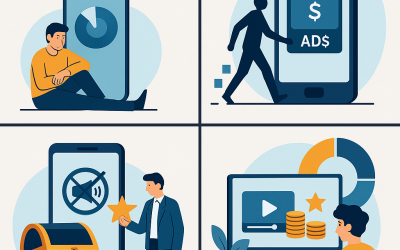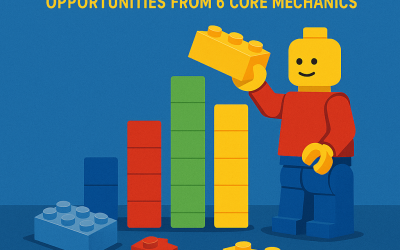How Game Distribution Channels Influence Monetization Strategies
Game developers today face more than just the challenge of building engaging content—they must also determine how to distribute and monetize their games effectively. Distribution channels not only influence your audience reach but directly affect which monetization strategies you can implement. A well-planned distribution strategy can increase your CPM, eCPM, and ARPDAU, while a poorly chosen one can limit your monetization potential. In this blog, we’ll explore how various game distribution paths—from app stores to web platforms—affect your ad revenue opportunities, especially for rewarded video ads and other in-game advertising strategies.
Contents
- 1 The Power of Distribution in Game Monetization
- 2 Monetization Tactics by Distribution Channel
- 3 The Impact of Distribution on CPM, eCPM, and ARPDAU
- 4 Mapping Monetization Models to Distribution Choices
- 5 The Central Role of Rewarded Video Ads
- 6 Case Study: Monetizing an HTML5 Puzzle Game
- 7 Choosing the Right Monetization Tools
- 8 Advanced Strategies for Distribution-Based Monetization
- 9 AppLixir Reward Video Ads
The Power of Distribution in Game Monetization
Game distribution channels shape the monetization models available to developers. Whether you’re releasing on mobile app stores, HTML5 web portals, or social platforms like Facebook Instant Games or Snapchat Minis, each channel has specific advantages and limitations. App stores often support rich monetization models like in-app purchases (IAP), rewarded video ads, and interstitial ads. Web platforms enable developers to bypass strict approval processes, allowing faster updates and more flexible monetization options like offerwalls and incentivized ads. Social channels emphasize virality and rapid user acquisition, creating opportunities for integrated ad revenue and content monetization.
These distribution decisions directly affect your monetization toolkit. For instance, HTML5 games distributed through web portals may thrive on rewarded video ads and offerwalls, while Unity-based mobile games released on Google Play or the App Store might rely heavily on IAP and Unity Ads. Understanding the unique monetization landscape of each channel is key to aligning your revenue strategy with user behavior and platform norms.
Monetization Tactics by Distribution Channel
Distributing your game through native app stores like iOS or Google Play unlocks powerful monetization mechanisms. Developers can combine freemium pricing with rewarded video ads, utilizing tools like Unity Ads or AdMob Rewarded Ads to generate steady ad revenue. These channels benefit from robust SDKs, high user retention, and established payment infrastructures, which collectively enhance app monetization performance. However, they also introduce challenges, such as compliance with platform policies and competition in overcrowded marketplaces.
On the other hand, distributing HTML5 or WebGL games through independent sites, game portals, or social embeds allows for more experimental monetization. These platforms support rewarded video ads, offerwalls, and even the Web Monetization API, which enables streaming micro-payments. Unlike app stores, web platforms offer instant publishing without approval delays. Though mobile ARPU on the web tends to be lower, developers can reach broader audiences and enjoy better control over their monetization structure.
Social platforms, such as Facebook Instant Games or Snap Games, create hybrid opportunities. These ecosystems combine viral user acquisition with platform-supported monetization via rewarded videos, native ads, and even offerwalls. Developers can tap into massive user bases and monetization networks (like Facebook Audience Network), though they must work within platform-specific SDKs and UI frameworks. The opportunity here lies in leveraging social graphs to grow organically while layering monetization tools tailored for social play.
The Impact of Distribution on CPM, eCPM, and ARPDAU
Cost-per-mille (CPM) and effective cost-per-mille (eCPM) are foundational metrics in ad monetization. CPM represents what advertisers pay for every 1,000 impressions, while eCPM is what developers actually earn, factoring in fill rates and revenue shares. These metrics vary significantly based on distribution.
Games distributed on app stores often benefit from high CPMs, especially when targeting iOS users in premium markets. Mobile video ads—particularly rewarded ads—deliver among the highest CPMs due to user engagement and retention. On web platforms, CPMs fluctuate more widely. Desktop users tend to yield higher CPMs than mobile users, and performance depends heavily on geography and ad placement strategy.
Web games also experience lower ARPDAU compared to native apps. Since web users often engage in shorter sessions, it’s essential to optimize rewarded video placements to boost engagement and session duration. Meanwhile, social platforms sit in the middle: they benefit from targeted audiences and frequent sessions but often face limitations in available ad formats and user segmentation tools.
Mapping Monetization Models to Distribution Choices
Different platforms support different monetization models, and aligning your strategy with the distribution channel can significantly impact revenue. For app stores, the most common models are freemium with IAP, rewarded videos, and interstitial ads. This model suits games with long-term retention and structured progression, where users are willing to pay or watch ads to advance.
HTML5 and WebGL games perform best with ad-supported models. Rewarded videos provide high engagement, while offerwalls and Web Monetization APIs offer alternative income streams. Subscription-based monetization is also emerging on the web, particularly for edutainment or productivity games.
Social games benefit from hybrid models. Rewarded videos can be contextualized with social sharing, while native ads and limited IAP options round out the monetization mix. Viral loops and player referrals are especially effective in boosting both user base and revenue on these platforms.
The Central Role of Rewarded Video Ads
Rewarded video ads are a common denominator across nearly all distribution channels. They deliver high CPMs, increase user engagement, and allow developers to monetize without disrupting gameplay. Unlike interstitials or banners, rewarded videos invite voluntary interaction by offering in-game incentives—such as extra lives, power-ups, or in-game currency.
Integrating rewarded videos varies slightly by platform. On mobile, SDKs like AdMob or Unity Ads offer seamless solutions. Web games often implement pre-roll ads through JavaScript SDKs, placing them before key actions or at natural gameplay breaks. Social games integrate video through platform-specific tools like Facebook Audience Network or Snap Ad Kit.
To maximize revenue from rewarded video ads, developers should tie video placement to meaningful rewards, maintain a fair ad frequency, and localize ads for international users. Optimizing placement—such as showing ads after failed levels or before critical actions—can lead to better user retention and higher eCPM.
Case Study: Monetizing an HTML5 Puzzle Game
Imagine a retro-themed HTML5 puzzle game distributed via a personal website and platforms like Kongregate or Itch.io. The monetization approach begins with integrating rewarded video ads to unlock hints and extra moves. This non-intrusive model keeps players engaged while generating revenue. Adding an offerwall offers another layer, letting users complete surveys or install apps in exchange for in-game currency.
The developer can further diversify by implementing the Web Monetization API. This enables streaming micro-payments for premium users with digital wallets, adding passive revenue on top of ad earnings. On average, this setup could yield $5–$15 eCPM on desktop and slightly lower on mobile. Offerwalls might contribute an additional 15–20% in ad revenue, and micro-payments from Web Monetization create a niche but consistent stream.
Choosing the Right Monetization Tools
Selecting the right tools is crucial. Unity Monetization is ideal for Unity-based games, whether on mobile or WebGL. AdMob Rewarded Ads dominate mobile ad monetization, while IronSource and AppLovin offer full-stack solutions for mediation and real-time bidding. For web-first experiences, developers can rely on AppLixir and custom video SDKs.
To optimize across multiple channels, developers often implement mediation layers. These tools dynamically choose the highest-paying ads across networks, boosting eCPM and maintaining fill rates.
Advanced Strategies for Distribution-Based Monetization
Developers can implement dynamic pricing strategies and segment-based monetization to further optimize revenue. Using analytics tools like Firebase or Unity Analytics, it’s possible to identify high-LTV users and offer them premium content, while serving more ads to casual users. A/B testing different ad placements, reward values, and user flows can reveal the most profitable combinations.
Integrating demand-side platforms (DSPs) into the mediation stack enables competitive bidding for ad slots, pushing eCPM higher. Meanwhile, tracking metrics like session length, impressions per user, and ARPDAU helps identify optimization areas. Ad revenue calculators can model earnings based on projected CPM, impressions, and user activity.
AppLixir Reward Video Ads
Game monetization success hinges on smart distribution choices. Whether you’re publishing a mobile app, launching a web game, or creating a social experience, your distribution strategy determines which monetization tools you can use and how profitable they’ll be. Rewarded video ads stand out as a consistent, high-performance option across all channels. Pair them with the right monetization models and analytics to unlock your game’s full revenue potential.


